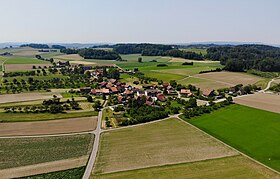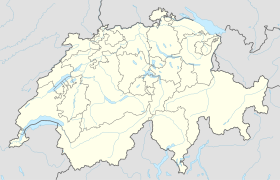Uerschhausen
| Uerschhausen | ||
|---|---|---|
| State : |
|
|
| Canton : |
|
|
| District : | Frauenfeld | |
| Political community : | Hüttwilen | |
| Postal code : | 8537 | |
| former BFS no. : | 4823 | |
| Coordinates : | 703 723 / 274 014 | |
| Height : | 467 m above sea level M. | |
| Area : | 2.93 km² | |
| Residents: | 108 (December 31, 2018) | |
| Population density : | 37 inhabitants per km² | |
|
View from the north |
||
| map | ||
|
|
||
Uerschhausen is a former municipality and a village in the municipality of Hüttwilen in the Frauenfeld district of the canton of Thurgau in Switzerland .
Uerschhausen belonged as a local community from 1803 to 1851 to the municipal municipality of Eschenz and then until 1996 to the municipal municipality of Hüttwilen. In 1862, Hof Hub was separated from the local community of Uerschhausen and assigned to the local community of Wilen bei Neunforn . On January 1, 1997 , Uerschhausen merged with the two local communities Hüttwilen and Nussbaumen as part of the Thurgau community reform to form the political community of Hüttwilen.
history
Pre-Roman times
The oldest evidence of human presence in the Seebachtal comes from the Mesolithic (9000–5500 BC) and goes back to nomadic hunters and gatherers who set up camp in the lake area. The finds are exclusively flint artifacts . On the basis of pollen-analytical investigations, already in the second half of the 5th millennium BC In the middle Neolithic , arable farming was practiced in the vicinity of Uerschhausen. The settlement is still unknown.
The oldest documented settlement is in the Nussbaumersee and belonged to the so-called Pfyner culture . The village was founded around 3840 BC. Built in BC; the last construction activities took place in 3582 BC. After a long break, the place was repopulated during the so-called Horgen culture (3300–2700 BC). A single mine house has been found from the subsequent Cord Ceramic Age. At the transition from the early to the middle Bronze Age (16th century BC) the same place was settled again. The most important settlement is on the Horn peninsula and dates to the latest Bronze Age (approx. 850–800 BC). The settlement area, which was extensively examined in the years 1985–90, covers around 10,000 m² and probably consisted of over 100 buildings. The houses examined were small buildings with a maximum length of 6 meters, which were used almost exclusively as residential buildings. There are no references to stables. The village must have been around 800 BC. BC probably because of the continuously rising water level of the Nussbaumersee, after it had been previously cleared according to plan.
In the older Iron Age , more buildings were erected on the southern edge of the late Bronze Age settlement area ( dendrodata between 660 and 635 BC).
→ see also section settlements in the article Nussbaumersee
local community

Burial mounds from the early Middle Ages were found in the village. Uerschhausen was first mentioned in 1212 as Urreshusin . The monasteries of St. Gallen and St. Katharinental were wealthy in Uerschhausen in the Middle Ages . In 1317 Pope John XXII published a bull because Uerschhauser had seized the property of St. Katharinental. The castle Helfenberg , mentioned in 1331, was already a ruin in 1413. Uerschhausen belonged to the Ittingen rulership until 1490 , then to the so-called high courts of the Thurgau bailiff until 1798 .
Ecclesiastically, Uerschhausen shared the fate of the Stammheim parish , and since 1828 Nussbaumen and Uerschhausen have formed a reformed parish . The Catholics have belonged to Uesslingen since the Reformation in 1524 .
The rural economy and settlement structure hardly changed in the 20th century.
| year | 1850 | 1900 | 1930 | 1950 | 1990 | 2000 | 2010 | 2018 |
| Local parish | 156 | 114 | 102 | 140 | 99 | |||
| Locality | 69 | 55 | 108 | |||||
| source | ||||||||
Of the total of 108 inhabitants in Uerschhausen in 2018, 8 or 7.4% were foreign nationals. 60 (55.6%) were Protestant Reformed and 18 (16.7%) were Roman Catholic.
Attractions
The prehistoric lakeside settlements Horn / Inseli has been part of the UNESCO World Heritage Site for Prehistoric Pile Dwellings around the Alps and, together with the Helfenberg castle ruins , is included in the list of cultural assets in Hüttwilen .
The Nussbaumersee is located east of Uerschhausen. Together with the Hüttwilersee and the Hasensee, it is one of the three Hüttwil lakes.
literature
- Albin Hasenfratz, Erich Trösch: Uerschhausen. In: Historical Lexicon of Switzerland .
This article is largely based on the entry in the Historisches Lexikon der Schweiz (HLS), which, according to the HLS's usage information, is licensed under the Creative Commons - Attribution - Distribution under the same conditions 4.0 International (CC BY-SA 4.0) license .
Web links
Individual evidence
- ↑ Swiss land use statistics. Completed on July 1, 1912. Published by the Federal Statistical Bureau. ( Memento from April 12, 2016 in the Internet Archive )
- ↑ a b c d Localities and their resident population. Edition 2019 . On the website of the Statistical Office of the Canton of Thurgau (Excel table; 0.1 MB), accessed on April 28, 2020.
- ↑ Population development of the municipalities. Canton Thurgau, 1850–2000 and resident population of the municipalities and change from the previous year. Canton of Thurgau, 1990–2018. On the website of the Statistical Office of the Canton of Thurgau (Excel tables; 0.1 MB each), accessed on April 28, 2020.
- ↑ Locations and Settlements Directory. Canton of Thurgau, 2005 edition . On the website of the Statistical Office of the Canton of Thurgau (PDF; 1.7 MB), accessed on April 28, 2020.
- ↑ Locations and Settlements Directory. Canton of Thurgau, 2012 edition. On the website of the Statistical Office of the Canton of Thurgau (PDF; 3.4 MB), accessed on May 11, 2020.
Remarks
- ↑ with outside courtyards






